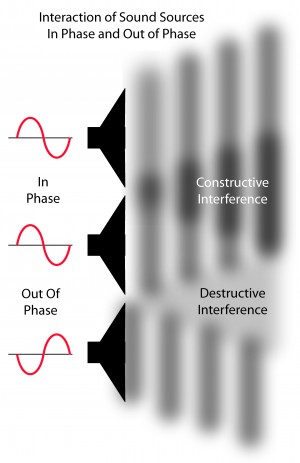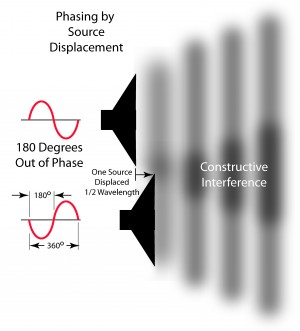Sound waves produced by multiple sources, or even within a single source in some cases, interact with one another to produce a variety of interesting and useful results. These interactions are commonly referred to as “interference” but one should not automatically conclude that this kind of interference is in any way related to the interference we often associate with radio or TV reception. Interference of sound waves in a constructive way is, in fact, essential in many circumstances.

Interference –
Two sound sources working in unison at the same frequency will, together, result in a higher amplitude or louder sound wave. This is called constructive interference.
We are all familiar with using multiple loud speakers to increase sound intensity. In bands and large orchestras, multiple instruments are used to produce the desired sound intensity for large concert halls. When two sound sources are combined in a constructive way, the result is not double the intensity of either one individually but it IS more intense than either source independently. More information is available in the previous blog about sound amplitude.
Sound sources operating in unison are said to be “in phase.” This simply means that the sources are both producing compressions and rarefactions at the same time. If the sources are “out of phase” it means that the timing of compressions and rarefactions are not synchronized. One source is producing compressions at a different time than the other although both are operating at the same frequency. If one source is producing a compression at the exact same time as the other is producing a rarefaction, the result is “destructive interference” as shown in the illustration.
Active sound cancelling headphones utilize destructive interference to eliminate unwanted external sounds in, for example, airplanes. A small microphone located on the outside of the headphone collects the ambient sounds and instantaneously reproduces the exact sounds (but vibrating in the opposite direction) to the headphone speaker. The result is that the person listening the the headphones does not hear those sounds.
Phase –
By convention, we divide repeating waves into degrees like the directions on a compass or the turning of a wheel. A full circle or a full cycle is comprised of 360 degrees. Two sound sources are operating to produce destructive interference as shown above are 180 degrees “out of phase.”
Phasing by Displacement –
So far we have only discussed constructive and destructive interference by changing the synchronization of stationary sources. In fact, constructive or destructive interference of two sound sources operating at the same frequency can also be achieved by displacing one source relative to the other. In the illustration below, the two sources, although operating 180 degrees out of phase are made to produce constructive interference by displacing one source by 1/2 wavelength in the direction of travel of the sound as shown below.

Practical Application –
Phasing and placement of stereo speakers is critical to proper sound reproduction. When connecting speakers, pay attention making sure that terminals are connected the same for all speakers. Also, random placement of speakers may, by chance, produce unwanted destructive interference.



 English
English Spanish
Spanish Chinese
Chinese Canada
Canada Mexico
Mexico United Kingdom
United Kingdom



